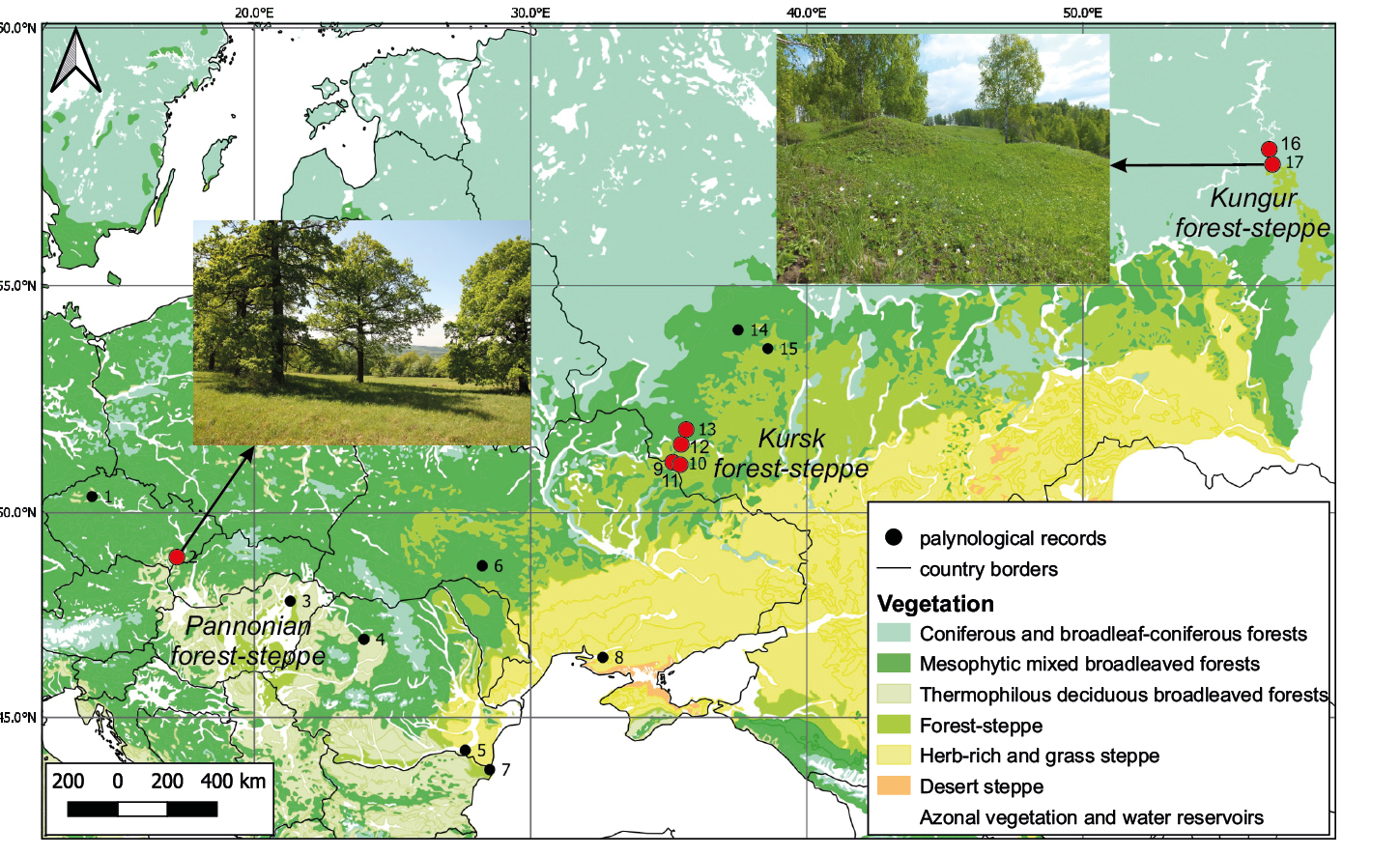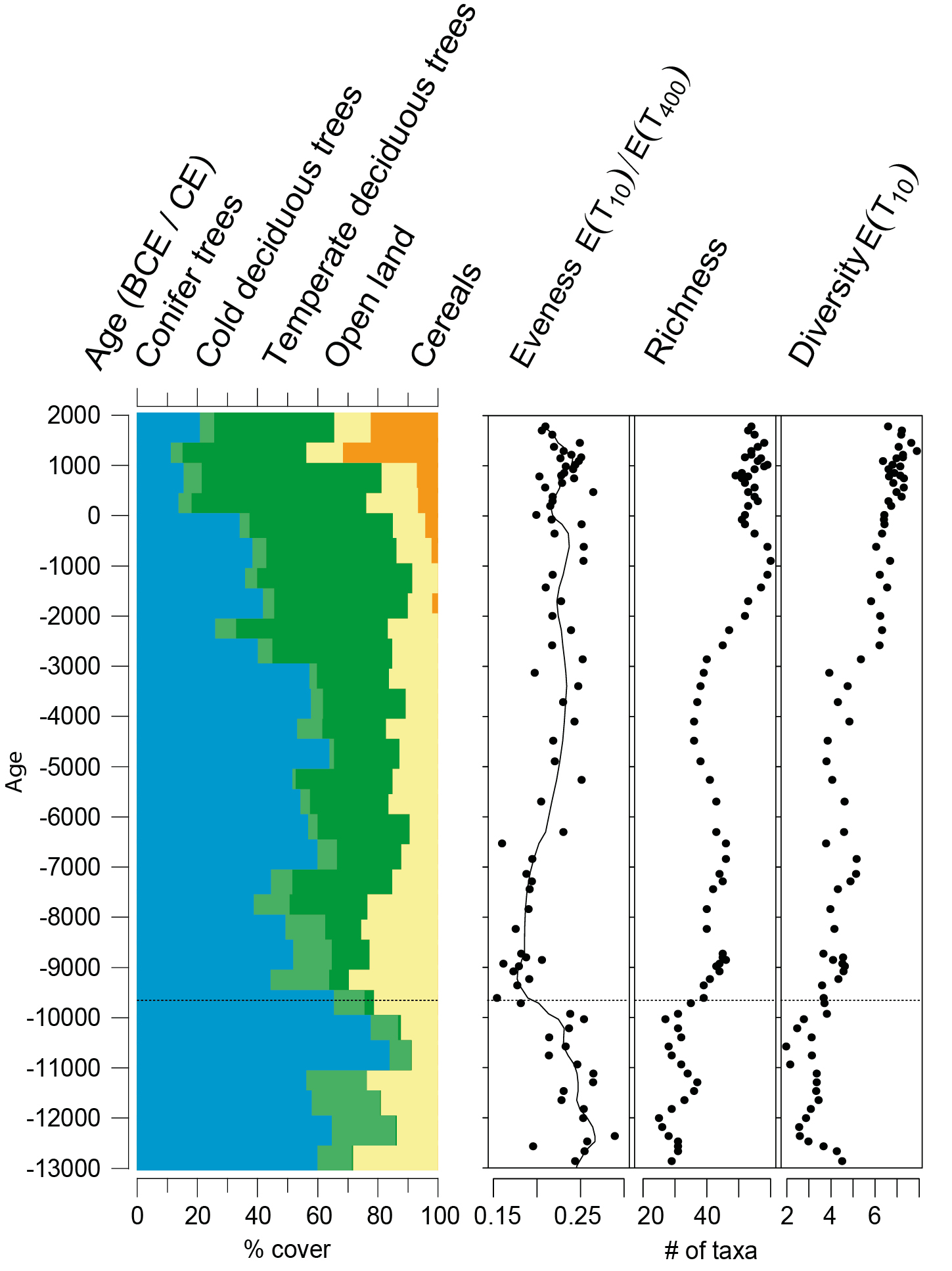- Home
- Publications
- PAGES Magazine
- Millennial-scale Perspective On Biodiversity Conservation of The Forest-steppe Ecotone In Europe
Millennial-scale perspective on biodiversity conservation of the forest-steppe ecotone in Europe
Giesecke T, Kuneš P and Shumilovskikh LS
Past Global Changes Magazine
30(1)
24-25
2022
Paleoecological studies document that grasslands with a high conservation value in the European forest-steppe ecotone are often anthropogenically derived, requiring management to avoid woodland recovery. Nevertheless, naturally open areas often persisted within this ecotone, explaining the high richness of these grasslands.
The forest-steppe ecotone
The European forest-steppe ecotone extends over 6000 km from the Carpathian to the Ural Mountains and is the natural transition from temperate broadleaf or mixed conifer forests to naturally open grasslands. Overall, this southeastern forest limit in Europe is determined by climate, while limiting parameters differ along its extent. The ecotone harbors many species-rich grasslands with high conservation value. At the same time, its Holocene history is not well documented, as indicated by the comparably small number of paleo studies in this region (Fig. 1).
The location, structure and composition of the ecotone likely changed through time as climate and land use changed over the course of the Holocene. Due to the fertile soils characterizing most of the region, it is extensively used for agriculture with few patches of natural vegetation remaining, and it is difficult to deduce the position of the ecotone based on modern observations. The transition zone may have consisted of a mosaic of forest and grasslands or uninterrupted open forest with a rich herb layer. Moreover, the mechanisms that maintained these semi-open forests or a forest grassland mosaic are not fully understood. Fires and grazing of large herbivores in combination with prehistoric land use may have shaped the structure in combination with geomorphology and local climate. Paleoecological investigations are paramount to uncover the natural position, structure, and disturbance regime to provide baselines needed for restoration efforts or management plans.
Situated at the foothills of the Ural Mountains, the Kungur region is the northern-most outpost of the East European forest-steppe zone. The high biodiversity and endemics in today’s grasslands gave rise to two competing concepts describing the Holocene history of the Kungur forest-steppe. The “Pleistocene relict” concept suggests that a birch forest-steppe like those occurring in Siberia today prevailed in the region during the Pleistocene and persisted during the Holocene. The “anthropogenic” concept suggests that the Pleistocene steppe was replaced by hemiboreal forests with the onset of the Holocene, with steppe elements surviving along rivers and on exposed rocks. Deforestation led to the establishment of secondary birch and pine forests and the spread of steppe elements, as they are found today. Resolving this debate on the origin of the Kungur forest-steppe is one of the many examples of how a millennial-scale perspective can provide guidance on nature conservation and restoration.
A new pollen record documenting the vegetation composition in the Kungur region over the last 3400 years (Shumilovskikh et al. 2021) demonstrates that the landscape was largely covered by hemiboreal forests. The oldest samples dating to the Bronze age document the presence of humans, who created larger open areas using fire. At the end of this settlement phase, the forest recovered quickly. Nevertheless, periods with little disturbance don't have a complete forest cover. During these periods and possibly also during the Early and mid-Holocene, steppe vegetation was likely restricted to exposed gypsum formations with low water retention.
Deforestation after the Russian colonization in the 17th century led to the opening of the landscape as it is today. Thus, the generally open character of the landscape is relatively recent and of anthropogenic origin, providing new habitats for the spread of steppe species. Based on available paleoecological data, the "Pleistocene relict" hypothesis can be rejected regarding the overall openness and structure while individual steppe elements may have survived in specific habitats.
Information documenting the anthropogenic formation of open areas also comes from the middle Dniepr forest-steppe region (Kursk, Russia). The Sudzha and Klukvennoe pollen records indicate the dominance of broadleaf with oak until 200 years ago when the area was transformed into an agricultural landscape. Other sites within the region such as Zamostye, Peny and Razdolye (Fig. 1) show the presence of pine-dominated forests indicating a high heterogeneity in standscale forest composition.
High-resolution pollen diagrams for the last 1100 years from Peny show strong forest reduction in the 13th century (connected to the Kievan Rus), forest recovery during the Tatar–Mongol invasions in the 14th century, and subsequent deforestations in the 15th century (connected to the Grand Duchy of Lithuania). The last deforestation pulse occurred in the 17th century when the Tsardom of Russia erected the Belgorod defense line to protect the fertile chernozem soil region against invaders from the south. Studied records document that the forest-steppe in the Kursk region was converted into the agropastoral steppe by the end of the 17th century.
Similar vegetation histories have been described for the western edges of the European forest-steppe ecotone. Here the prevailing hypothesis of an Early Holocene closed forest that was opened through human activity (Mitchell 2005) can be rejected using paleoecology. An interdisciplinary study of Lake Vracov at the western outcrops of the Pannonian Basin documents that open vegetation persisted from the Late Glacial into the Holocene (Kuneš et al. 2015; Fig. 2). In central and western Europe, the warming with the onset of the Holocene resulted in the spread of trees or increase in tree cover. This replacement of open vegetation types is visible in pollen diagrams as a decline in pollen-type richness (Giesecke et al. 2019). The data for Lake Vracov show the opposite trend of an increase in pollen-type richness at the onset of the Holocene.
Pollen-type richness and diversity can be interpreted as floristic richness and landscape diversity (Matthias et al. 2015); both increased at the onset of the Holocene at Lake Vracov. Richness and diversity further increased around 2000 BCE with the appearance of cereals, indicating the expansion of agriculture in the region. This example shows that although there was a continuation of open vegetation types, early land use further enhanced floristic richness and landscape diversity.
In addition to this example, the Holocene persistence of open land is documented in other lowland areas in this western region (Kuneš and Abraham 2017). Paleoecological information therefore support the hypothesis that the long-term stability of these ecosystems explains the existence of species-rich grasslands, with high conservation value, such as those in the Bílé Karpaty Mountains (Hájková et al. 2011).
Conclusions
The anthropogenic origin of many European open vegetation types is documented in a multitude of palynological studies. Also the forest-steppe ecotone was transformed by land use. While Neolithic to Iron age cultures reduced the forest cover of the ecotone somewhat, the transformation to a largely open agrarian landscape occurred only between 500 BCE in the Lower Danube region (Feurdean et al. 2021) and the 17th century in the Kungur forest-steppe (Shumilovskikh et al. 2019b, 2021). In eastern Europe, this deforestation likely shifted the ecotone to the North and West so that areas that are currently mapped as forest-steppe were forest-covered before extensive land-use started (Shumilovskikh et al. 2018).
Due to this transformation of the landscape, the cessation of agricultural activities would lead to a recovery of woodlands in most locations within the forest-steppe ecotone and a loss in the diversity of steppe associations over the medium-term. The open character of many vegetation types within the region depends on disturbance and conservation must therefore include disturbance factors in the form of selective felling, prescribed burning, moderate grazing, or traditional mowing.
affiliations
1Department of Physical Geography, Utrecht University, The Netherlands
2Department of Botany, Faculty of Science, Charles University, Prague, Czech Republic
3Department of Palynology and Climate Dynamics, University of Goettingen, Germany
contact
Thomas Giesecke: t.giesecke uu.nl
uu.nl
references
Bohn U et al. (2003) Map of the Natural Vegetation of Europe. Landwirtschaftsverlag, 530 pp
Feurdean A et al. (2021) Biogeosci 18: 1081-1103
Giesecke T et al. (2014) Veg Hist Archaeobot 23: 217-228
Giesecke T et al. (2019) Nat Commun 10: 5422
Matthias I et al. (2015) J Ecol 103: 880-890
Hájková P et al. (2011) Preslia 83: 185-204
Kirschner P et al. (2020) Nat Commun 11: 1968
Kuneš P et al. (2015) Quat Sci Rev 116: 15-27
Kuneš P, Abraham V (2017) In Chytrý M et al. (Eds.) Flora and Vegetation of the Czech Republic, 1st ed. Springer, 193-227
Mitchell FJG (2005) J Ecol 93: 168-177
Shumilovskikh LS et al. (2018) J Veg Sci 29: 416-426
Shumilovskikh LS et al. (2019a) Veg Hist Archaeobot 28: 513-528
Shumilovskikh LS et al. (2019b) Rev Palaeobot Palynol 270: 1-7
Shumilovskikh LS et al. (2021) Biodivers Conserv 30: 4061-4087
Svobodová H (1992) The development of the southern Moravian vegetation in the Late Glacial and Holocene [in Czech]. Doctoral dissertation. Institute of Botany, CAS, Průhonice, Czech Republic

